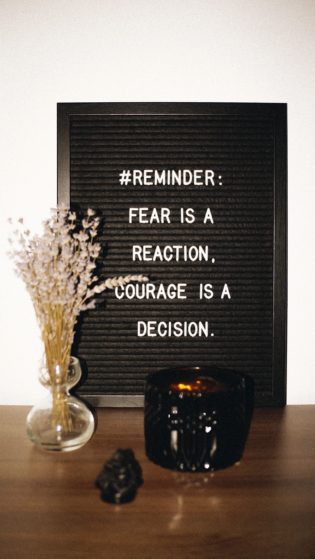I spent more than 20-something odd years of my life struggling with anxiety. And if you know anxiety, it warps your perception of how situations really are, how you see yourself and how you believe people see you. These perceptions lead to unhealthy behaviors that only reinforces the anxiety and confirms your belief in what the anxiety is telling you. For example, as a child I used to think that I “was stupid because I had failing grades” and because I was “stupid, I was unworthy.” Thoughts like this began to stack, one unhelpful thought after the other, eventually leading me to avoid doing anything that was challenging. Being a target of relentless bullying also caused me to socially withdraw and internalized more of the negatives messages. I began to avoid people like the plague and hardly spoke a couple of full sentences throughout any given day. My world got smaller and smaller. Why? Well, why would anyone do something challenging if they believe they were “too stupid” to succeed in trying? What’s the point? And, if you think you’re unworthy and are being bullied, why would you make efforts to have friends? Because having friends would contradict and violate this belief – having friends would mean you ARE worthy of love, friendship and respect. Do you see where I am getting at? Anxiety convinces you that every situation will have a terrible outcome. It convinces you that everyone sees you in the worst light. Over time, my anxiety grew more specific towards social settings and social interactions – my efforts for self-protection through isolation and avoidance eventually made things worse.
A lot of people struggle with social anxiety for many different reasons.
First of all – let me be clear – social anxiety is not the same as being “shy.” I avoided people because I was struggling with intense fear and worry – worry that they will cause emotional or physical pain; worry that they will see how “ugly” I was underneath; worry that by trying anything positive would only lead to further disappointment. Unfortunately, social anxiety is often dismissed as just shyness – so many wait very long or never get the help they need. Throughout the majority of the years, for example, I didn’t even know it was anxiety – it was written off as “shy.” However, social anxiety is much more debilitating and impairs a person’s ability to function at baseline – people with social anxiety don’t just feel nervous before going to a social event, for example. They may worry about it for weeks or even months beforehand, lose sleep due to anxiety, become irritable, and have intense somatic symptoms such as racing heart, shortness of breath, sweating, or shaking.
 Yet, the worries that come from social anxiety are lies – lies that causes you to underestimate your abilities to cope and overestimates the circumstances – they are distortions and are very unhelpful. And while the lies vary from person to person, the behavioral outcomes are very similar – the most common being, AVOIDANCE.
Yet, the worries that come from social anxiety are lies – lies that causes you to underestimate your abilities to cope and overestimates the circumstances – they are distortions and are very unhelpful. And while the lies vary from person to person, the behavioral outcomes are very similar – the most common being, AVOIDANCE.
My social anxiety became very prominent to me after I graduated from high school. A lot of my survival mechanism of avoidance no longer provided the same effect – instead, the consequences of using them for all those years robbed my natural development of important social skills required for the challenges of adulthood. My isolated lifestyle during my childhood and adolescent years meant I had to unlearn and relearn how to connect with another human being while also truly being myself.
Ironically, like most things, what seems like weaknesses at first can become our greatest strengths later. I ended up becoming a therapist!
Overcoming Social Anxiety
We change our behavior when the pain of staying the same becomes greater than the pain of changing. Consequences give us the pain that motivates us to change.”― Dr. Henry Cloud, PhD
To overcome any fear, you have to embrace the fear. You must actively move towards it and learn to love the pain and discomfort that comes with it.
So how do you do that?
How did I work through my social anxiety?
I had to educate myself on what this monster was – I had to understand what I was dealing with.
After realizing and accepting how much the social anxiety was holding me back from many aspects of life, I did everything I possibly could. I went full-tilt and immersed myself into the world of social skills. I took theater, acting, improv, public speaking, went to counseling, learned effective communication skills, read countless books, and even worked with dating coaches and spent time with people I viewed as charismatic. This became a 6-year journey – yes, a long time – it went from trying to overcome my social anxiety to a newfound curiosity and interest in this particular niche. My goal of overcoming the anxiety changed to the goal of mastery. I enjoy getting good at it and saw value in the practice.
Did the anxiety itself ever went away? Not really. Today, I still have anxiety, but everything’s changed. EVERYTHING.
What I’ve learned through my own self-transformation and helping others is that we cannot get rid of uncomfortable feelings or emotions, anxiety included. BUT, we can change how we think about it, how we respond to it, what we do with it and ultimately, how we can leverage it.
I learned the hard way and the long way.
Most people who attempt to overcome social anxiety tend to think that acquiring social skills by learning communication techniques is the way to go. But, I can assure you that even if you have great communication skills and know how to give a great speech, you won’t be able to deliver and execute effectively if you cannot handle pressure — if you’re not comfortable with being uncomfortable.
Not to say learning social skills is useless – it’s great! – I just have a better solution!
Social Mishap Exposure
While it helps to learn social skills, especially as an early intervention to social anxiety – the skill itself is not what alleviates the anxiety – given that the anxiety is so hardwired, deep-seated and embedded by the time most people actually decide to get treatment. Social anxiety causes an emotional and somatic experience that is uncomfortable, often associated with an intense fear of being judged negatively or rejected. In very severe cases, people will experience panic attacks. The best way to deal with social anxiety is to get really good AND comfortable with managing discomfort – by getting your hands dirty and actively immersing yourself in situations that provokes the anxiety.

“You mean to tell me that to overcome my anxiety, I will need to do the thing that causes me anxiety?” Yes. Take a deep breath. I know this is a scary thought! Bear with me for a moment longer and let me explain.
You see, the anxiety that you feel is not the problem. It’s the behavior that you engage in DURING and AFTER you feel anxious that perpetuates and reinforces the anxiety over time. I’m talking about the number one behavior I mentioned in the beginning of this blog – – the behavior most people with social anxiety engages in: AVOIDANCE. Avoidance tells your brain: “Yes, I should be afraid of this worry I have.” The fantasy or imaginary fear becomes so intense that you rather not risk the possibility of it playing out in real life. Each and every act of avoidance – big and small – feeds the anxiety. The monster gets stronger, while you get weaker. Ultimately, every time you avoid doing the scary thing, you rob yourself of learning and developing the necessary strength to manage and tame the anxiety.
This needs to stop.
I want to introduce to you the best method I know: Social Mishap Exposure. If you’ve never heard of this therapy technique, you are in for a treat! – I love this technique – it’s fun for me and it works.
It’s really simple – the goal of the social mishap exposures is for you to experience the feared social outcomes that you try so hard to avoid. So, if you’re worried that you’d appear incompetent, silly, shy, and so forth – go do that thing you are worried about on purpose. Think of it as a behavioral or social experiment – if your worry came true, was it as bad as you imagined? If your worry didn’t come true, what did you learn? The reason why I like this approach is because it breaks the cycle of avoidance, which forces people to re-evaluate the perceived threat of a social situation, especially after experiencing that social mishaps do not lead to any long-lasting, irreversible and negative consequences. In addition, it also builds distress tolerance (which is just a clinical word that describes courage) – the ability to manage actual or perceived emotional distress. Increased distress tolerance means everything and anything less than your hardest challenge will manageable – sometimes it even feels like a walk in the park. Other interventions and approaches for social anxiety will attempt to help people realize how unlikely their worries will happen. The truth is, however, some of these worries are very valid and some are likely to happen! Sometimes there IS a 50-50 chance. So engaging in a power struggle with your anxiety and attempting to convince yourself that your worry is irrational can backfire. Social mishap creates a mindset that is more sustainable and unstoppable so that you can live the life you want and be unapologetically YOU – the kind that moves away from “why” to “why not” and “what if” to “so what.”
I learned that courage was not the absence of fear, but the triumph over it. — Nelson Mandela
Let me get more specific and paint a clearer picture for you.
When I supported men struggling with social anxiety, often around dating, I helped them intentionally create a hierarchy of fears – basically a list of feared negative consequences of a specific feared social situation. We would brainstorm all kinds of scenarios – as many as their anxiety could come up with. Once we had a comprehensive list, I would have them rate each one on a scale from 1-10, based on level of fear. And then, we would design objectives and actionable items to tackle each fear – working up the ladder, starting with the least feared situation.
Here are some examples of powerful exposure exercises I’ve actually done with them:
- Walk backwards on a crowded public street for 1 minute
- Sit down on the floor for a minute in the middle of an aisle of a busy store
- Give a genuine compliment that’s specific to the next 10 people you see
- Ask a stranger for directions
- Call a random number and ask the person on the phone for movie suggestions to watch
- Approach 10 random strangers at the mall and kindly tell them you’re experimenting with social mishap because you’re working to overcome social anxiety
- Identify 5 strangers in public that you think looks intimidating and go say “hi” to them
- Go offer to take a photo for a stranger who is taking a selfie with their family/friends and instead be in the photo with them
These exposures may seem ridiculous and intimidating at first – you may even feel the cringed reading them – and they are – but it works! Much like building a muscle in the gym: the more repetition you do, the stronger you become – thus, making the previous challenge feel easy. The point of social mishap is to build social courage – so that when you seriously do want or find opportunities to talk to that attractive girl, go on that date, do that speaking gig, ask your boss for that raise, or run that workshop, you are more willing and able to reaffirm who you are and what matters most and jump on that chance. Social mishap will help you build a different relationship with the anxiety as you face the fears head on, allowing yourself to feel the fear, survive it, and move beyond it. But, you have to actively come up with creative ways to bring the fear out of hiding – to leave no stone unturned!
This is important.
Social anxiety likes to operate within social norms and follow social rules – sometimes to the extreme – and the anxiety will rationalize and confine you into a box of, “don’t do that, don’t do this, you’ll look stupid or weird, people will laugh.” The result is a lot of people-pleasing, low self-esteem, copycats and living a soul-draining, boring, “safe” life with a lot of regrets.
Be who you are and say what you feel because those who mind don’t matter and those who matter don’t mind — Dr. Seuss
Yes, people might laugh. Yes, you might fail. Yes, you might get rejected. Yes, you might look silly. Yes, people might not agree with you. But isn’t that what makes life interesting? These types of thoughts will stop you from trying and discourage you from being authentic or living out your best life. The anxiety is relentless and it will lead to a lot of missed opportunities…until, you say, “So what?”
“So, what if I look silly – I’m being myself. People who like me will like me for me and not who I pretend to be.”
“So, what if I get rejected – I wouldn’t know if I didn’t try. For all I know, that person could be my future wife!”
 This could be the greatest moment(s) you’ve ever lived – but it’s going to take courage.
This could be the greatest moment(s) you’ve ever lived – but it’s going to take courage.
This is not a message to encourage you to be reckless and violate the rights of others or engage in unsafe and destructive behaviors that can cause harm.
You don’t just go into the gym and decide to bench 315lbs if you’ve never benched before, would you?
Work up to it.
You need to build the strength to handle heavier loads of stress.
Take calculated risks that are value-driven.
Don’t rush it.
Pace yourself from one feared situation to the next before moving onto greater challenges.
My Recommendations
Studies confirm the two methods that I would recommend to someone struggling with social anxiety:
- Cognitive Behavioral Therapy (CBT). Cognitive behavioral therapy (CBT) has proven to be the most effective form of treatment for social anxiety. The central goal of CBT is to identify unhelpful beliefs and thoughts and replacing them with more helpful thoughts. CBT teaches you to become more aware of how your thoughts, emotions and behaviors are all linked together. Understanding this mechanism on a personal level is vital. One of the most important keys for success in CBT depends largely on your willingness and ability to confront and challenge those unhelpful thoughts. CBT is effective because it is intensive and requires active participation (vs just passive talk therapy). Like previously mentioned, your progress depends on your level of effort and engagement in the process. Social mishap exposure is a behavioral technique known as systematic desensitization that is often used by a CBT therapist. So, ensure that you find a certified CBT therapist who specializes in social anxiety – whether it’s individual or group therapy.
- Improvisational Theater (improv). One of the best ways to engage in social mishap exposure is by taking a course or workshop on improvisational theater (or just simply, improv). The use of improv to reduce social anxiety is perhaps one of the best things you can do – heck, it’s good for you even if you don’t have social anxiety. Improv is basically a form of theater in which you perform and act out skits that are unplanned, unscripted and relies on your spontaneity and intuition to build a story. No one, not even the instructor ever knows how a scene will begin or end. It’s about trusting the process. The reason I recommend improv vs a typical public speaking class or social skills class is because it removes the “safety” of planning and “structure” altogether. Real social interactions, social dynamics and interpersonal relationships are mostly unpredictable, impromptu, spontaneous and unplanned. Life is not going to wait for you. If you have to rely heavily on planning and practicing a scripted speech or what you’re going to say, that creates another barrier that reinforces social anxiety. Improv, surprisingly, engages you in exercise that teach you to be fully present, to be a better active listener, to be more intuitive, socially aware, more creative, more trusting of yourself, and to be less judgmental of your own thoughts, so that your authentic and creative self can flow. Most importantly, the classes create a culture of safety – a safe space where you can “fail” and be silly, goofy, and weird! The improv instructor I had was wonderful – she, for example, taught the group to celebrate our social mishaps during class together, whenever one of us “messed” up. If one of us was doing a skit and we said something that just didn’t make any sense or we stumbled to find the right words, she prompted us all (those acting in the skit and those sitting in the audience) to stop and take a moment to embrace that “failure” and own it with humility and celebration – sometimes by shouting out “I screwed up!” and everyone would applause you and say “you screwed up, yay!” This might sound bizarre – but it taught me to not take myself so seriously and that it’s not the end of the world. You may find it helpful to find an improv course specifically for social anxiety (vs a mainstream course).
By combining CBT therapy with improv work, you are on a GREAT journey to break free from social anxiety. Notably, studies found the most significant improvements in individuals who were more engaged and actively participated in social mishap exposures and improv classes. That means, you have to put in the work!
Let me end this with a wonderful Native American fable:
An old Cherokee is teaching his grandson about life. “A fight is going on inside me,” he said to the boy. “It is a terrible fight and it is between two wolves. One is evil – he is anger, envy, sorrow, regret, greed, arrogance, self-pity, guilt, resentment, inferiority, lies, false pride, superiority, and ego.”
He continued, “The other is good – he is joy, peace, love, hope, serenity, humility, kindness, benevolence, empathy, generosity, truth, compassion, and faith. The same fight is going on inside you – and inside every other person, too.”
The grandson thought about it for a minute and then asked his grandfather, “Which wolf will win?”
The old Cherokee simply replied, “The one you feed.”
You have a choice. Always.
About the Author
Albert Nguyen is a licensed psychotherapist in private practice. He specializes in providing an integrative and eclectic approach to mental health care that includes personal self-care, anxiety and depression, and peak performance in children, teens and adults. Reach out for more information on how he can be of service to you here.
Disclaimer: The topics and articles published on this website including text, graphics, videos and other materials are for informational purposes only and should not be substituted for professional medical advice.






